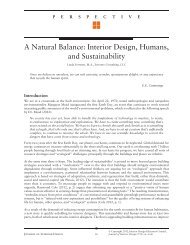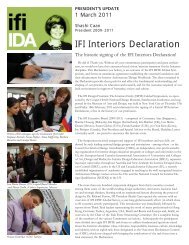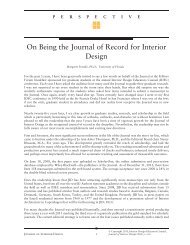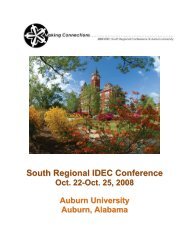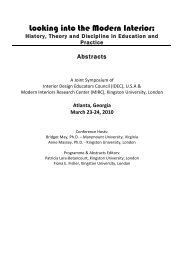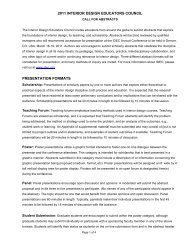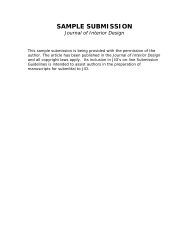2002 Conference Proceedings - Interior Design Educators Council
2002 Conference Proceedings - Interior Design Educators Council
2002 Conference Proceedings - Interior Design Educators Council
You also want an ePaper? Increase the reach of your titles
YUMPU automatically turns print PDFs into web optimized ePapers that Google loves.
RECONCILIATION AND LEARNING THROUGH FURNITURE ANDCULTUREPaper byMarina Lommerse andKaren McRobbCurtin UniversityPurposeSet in period of Australia’s attempted reconciliation with indigenous peoples, thisresearch explores how <strong>Interior</strong> Architecture students learned from a project with acultural influence—specifically how they assimilated cultural imagery and translated itinto useful objects for contemporary homeowners. Through the study of a furnituredesign course—the structure, the resulting work, audience reactions and studentsreflections—the researchers analyze the social context and results of applying Aboriginalcultural heritage to furniture.To explore if Aboriginal cultural awareness could be successfully incorporated into adesign and act as a reconciliation tool, the research question was posed: what did thestudents learn about cross-cultural analysis and design application and how did theylearn it?MethodologyResearch Setting. Aboriginal Australians traditionally hunted and gathered over areasdefined by custom. In addition to providing sustenance the land was a materialization ofthe journeys of the creative ancestors, the basis of spiritual life. Systems of land tenurewere intimately bound up with spiritual attachment and notions of custodianship. Assettlement spread, indigenous people were subjected to government policies thatattempted to variously displace, convert, isolate and eventually assimilate them. The1990’s brought about a movement of reconciliation and a request by Aboriginal peoplefor the government to ‘say sorry’ for the wrongs committed.Author one set up a program in the second year of the BA (<strong>Interior</strong> Architecture)[anonymous university] to explore Aboriginal cultural values and translate them intofurniture for contemporary use. The objectives were: one, to give the student a vehicleto understand Aboriginal culture, and two, to help them develop a process for exploringthe culture and translating chosen elements into tangible furniture pieces. Studentswere to design and build a full-scale prototype of a piece of furniture or a functionalobject for the home to reflect Aboriginal art, culture or environment.Data Collection and Analysis. For this exploratory and interpretive research, datacollection methods included a sample group participating in a questionnaire and a focusgroup discussion. The data was processed to find patterns and differences betweenstudents’ learning and cross-cultural understanding, and how this was applied to adesign. Included is a selection of furniture pieces as case studies, analyzing theprojects’ cultural influence and design processes.8






